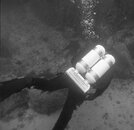Your first move should be to isolate unless you are 100% certain which post failed (bet your life on it). Anything else is nonsense...
That is one of the many reasons I keep my isolation valve shut unless I am equalizing cylinders. The technique is called Progressive Equalization.
You treat any losing-gas failure like independent doubles (back or side mount), it doesnt really matter which side of the first stage the leak is on. You switch to the backup cylinder and regulator if the failure occurs on the primary/online cylinder. Then you can close the post valve on the failed side and abort the dive. That can preserve some breathable gas IF the leak is upstream of the first stage HP seat.
Of course, opening and closing the isolation valve 2 to 6 times per dive can get old if it is difficult or awkward to reach, which was one of the many reasons I built a protector for valve-down doubles. For me, reaching the isolator on valve-up doubles is not that bad several times/dive in a 3mm wetsuit. Unfortunately it is much slower and uncomfortable in a drysuit with cold-water underwear.
BTW: This article is worth looking at when considering you strategies in a losing-gas failure.
Life Ending Seconds, 3000 to Zero in 72 Seconds





